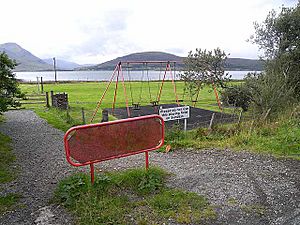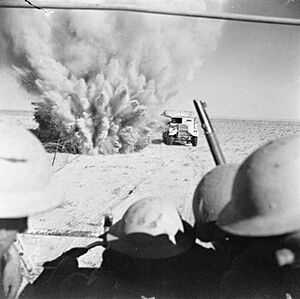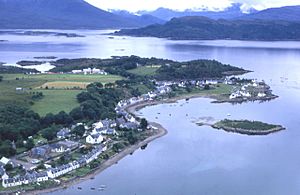Sorley MacLean facts for kids
Quick facts for kids
Sorley MacLean
|
|
|---|---|
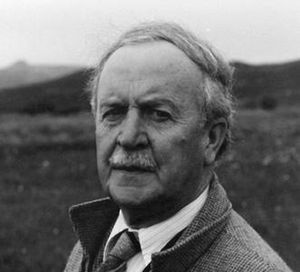
MacLean at Braes, Skye in 1986
|
|
| Native name |
Somhairle MacGill-Eain
|
| Born | 26 October 1911 Òsgaig, Raasay, Scotland |
| Died | 24 November 1996 (aged 85) Inverness, Scotland |
| Resting place | Stronuirinish Cemetery, Portree |
| Occupation | English teacher Head teacher |
| Language | Scottish Gaelic |
| Education | Raasay Primary School Portree Secondary School |
| Alma mater | University of Edinburgh |
| Genre | Gaelic poetry |
| Years active | 1932–c. 1980 |
| Notable works |
Dàin do Eimhir
|
| Notable awards |
Queen's Gold Medal for Poetry
|
| Spouse | Renee Cameron (m. 1946) |
| Children | Three daughters |
| Website | |
| (Gaelic) (English) |
|
Sorley MacLean (Scottish Gaelic: Somhairle MacGill-Eain; 26 October 1911 – 24 November 1996) was a famous Scottish Gaelic poet. Many people consider him one of the most important Scottish poets of modern times. He was known for his amazing skill with the Gaelic language. He also connected his poetry to European history and politics.
A famous poet named Seamus Heaney said that MacLean saved Scottish Gaelic poetry. MacLean grew up on the island of Raasay in a family that followed a strict religion. He learned a lot about Gaelic culture and stories from a young age. Later, he became a socialist.
In the late 1930s, he became friends with other Scottish writers. He fought in World War II in North Africa and was injured. After the war, he didn't publish much new work because he wanted everything to be perfect. In 1956, he became a head teacher at Plockton High School. There, he worked hard to encourage the use of the Gaelic language in schools.
MacLean's poems mixed old Gaelic traditions with ideas from Europe. He often compared sad events from Scottish history, like the Highland Clearances, to modern problems, such as the Spanish Civil War. His unique style helped bring Gaelic traditions back to life. It also made the Gaelic language feel new and modern. His most important works, Dàin do Eimhir and An Cuilthionn, came out in 1943. But he only became widely known in the 1970s when his poems were translated into English. His later poem Hallaig (1954) became very popular. It described a village that lost its people during the Clearances. This poem became a symbol of Scottish Gaelic poetry for English speakers.
Contents
About Sorley MacLean's Life
Growing Up in Raasay
Sorley MacLean was born in Òsgaig, Raasay, on 26 October 1911. Scottish Gaelic was his first language. He spoke very little English until he started school at age six. He was the second of five sons. His parents, Malcolm and Christina MacLean, owned a small farm and a tailoring business.
His family later moved to a better house. This caused money problems when the Great Depression made tailoring difficult. His brothers and sisters also became teachers or doctors. Sorley's family had a long history in Gaelic culture. They knew many old songs and stories passed down through generations.
His mother's family had been involved in fighting for tenant rights in the Highlands. Both sides of his family had been forced off their land during the Highland Clearances. Many people in his community still remembered these events clearly. What MacLean learned about the history of the Gaels, especially the Clearances, greatly shaped his views.
His grandmother, Mary Matheson, lived with the family. She taught him many traditional songs. MacLean himself could not sing. He believed this was why he felt driven to write poetry instead.
His Views on Religion and Society
MacLean grew up in a very strict religious church. This church believed that only a small number of people would be saved by God. The rest were thought to be doomed. They also did not allow any fun activities on Sundays.
MacLean later said he stopped believing in this religion when he was twelve. He could not accept that most people were meant for eternal punishment. He became a socialist instead. He felt strongly about helping those who were unhappy, unsuccessful, or oppressed.
He kept a dislike for worldly wealth and power. Later in life, he had mixed feelings about the church. He criticized how it sometimes stopped Gaelic songs and stories. But he also admired the powerful language of Gaelic sermons. These sermons influenced his own poetic style.
Student Life and Early Career
MacLean went to Raasay Primary School and then Portree Secondary School. In 1929, he went to the University of Edinburgh. He studied English because it was cheaper than studying Celtic languages. He later wished he had studied Celtic more.
While at Edinburgh, he also took classes in the Celtic department. He was involved in left-wing politics and sports. He even protested against Oswald Mosley and his fascist group. In Edinburgh, he saw a lot of poverty and crowded living conditions. This was especially bad because of the Great Depression.
After graduating in 1933, he stayed in Edinburgh to train as a teacher. There, he met the famous poet Hugh MacDiarmid.
Teaching and War Service
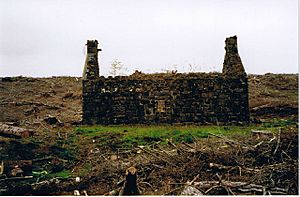
In 1934, MacLean returned to Skye to teach English at Portree High School. When the Spanish Civil War started in 1936, he thought about joining the fight. But he had to stay home because his mother was very ill. His father's business was also struggling.
In 1938, he taught at Tobermory High School on Mull. This year deeply affected him. Mull had been badly damaged by the Clearances in the 1800s. Many of his own family, the MacLeans, had been forced out. He felt that the beauty of Mull, combined with the sad history of the Clearances, was almost unbearable.
He also worried that fascism would win in Europe. He was sad about the continuing decline of the Gaelic language. Between 1939 and 1941, he taught in Edinburgh and Hawick. During this time, he wrote most of the poems for Dàin do Eimhir. He also became good friends with other Scottish Renaissance poets.
When World War II began in 1939, MacLean wanted to join the army. But he was needed as a teacher. He was drafted into the Royal Corps of Signals in 1940. He was sent to North Africa in 1941. He was injured three times. His military service ended in November 1942 during the Second Battle of El Alamein. A land mine exploded near him, breaking bones in his feet.
MacLean wrote some poems about the war. He questioned the old Gaelic idea of heroism. He felt that physical bravery could be used for good or evil. He believed it was not always a good thing, especially when used by Nazis.
Life After the War
MacLean returned to Britain in March 1943 to recover. He was discharged from the army in September. He went back to teaching in Edinburgh. There, he met Renee Cameron in 1944. They married in 1946 and had three daughters. Their marriage was happy, and friends said MacLean became calmer with family life.
He was never a member of the Communist Party. After the war, he was disappointed by the Soviet Union's actions in Poland. But he kept his socialist beliefs and his strong commitment to social justice. He often reviewed poetry and made friends with younger poets. In 1947, he became a head teacher of English. But he wanted to return to the Scottish Highlands.
In 1956, MacLean became the head teacher of Plockton High School in Wester Ross. This was a challenging job because it was hard to find teachers for such a remote area. He often had to teach many subjects himself. At Plockton, he strongly supported using Scottish Gaelic in schools. He pushed for a special exam for students learning Gaelic. Before 1968, Gaelic learners had to compete with native speakers. MacLean felt this was unfair.
He believed Scottish children would benefit from learning three languages, with Gaelic being one of them. He had high expectations for his students. He also encouraged them to play shinty, a traditional Scottish sport.
MacLean's friends often talked about his vast knowledge of local history and family trees. He remained active in left-wing politics, joining the Scottish Labour Party. In his later years, he published few poems. This was because he cared more about quality than quantity. His family and job also left him little time to write.
After retiring in 1972, MacLean moved back to Skye. He lived in his great-grandmother's house with views over the Sound of Raasay. After his poetry was published in English, he became famous around the world. He traveled to places like Rotterdam and Berlin for poetry readings.
He was a writer-in-residence at the University of Edinburgh from 1973 to 1975. He welcomed young Gaelic poets there. He also helped found Sabhal Mòr Ostaig, a Gaelic university on Skye. In 1993, his daughter Catrìona died. MacLean and his wife helped raise her three children. He passed away on 24 November 1996, at age 85.
Sorley MacLean's Poetry
Why He Wrote in Gaelic
Before university, MacLean wrote poems in both English and Gaelic. But in 1932, after writing a Gaelic poem called A' Chorra-ghritheach ("The Heron"), he decided to write only in Gaelic. He even burned his earlier English poems. He felt that if poetry came to him, "it had to come in Gaelic."
He also wanted to help save and develop the Gaelic language. Gaelic had been declining for centuries. In 1931, only 3% of Scotland's population spoke Gaelic. Sometimes, MacLean worried that Gaelic would not survive. He feared his poetry might not be understood.
Gaelic literature has a rich history of songs and poems going back 1,500 years. MacLean knew this history very well. He was especially inspired by the love poems of Uilleam Ros from the 1700s. MacLean most admired the old Gaelic songs made by unknown poets. These songs were passed down through generations by word of mouth. He once called Scottish Gaelic song-poetry "one of the greatest artistic glories of Europe."
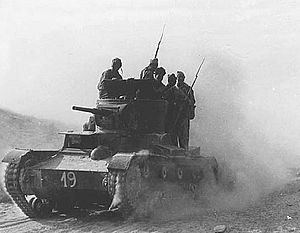
MacLean said that political figures meant more to him than any poet. He was inspired by leaders like Vladimir Lenin and Joseph Stalin. Other left-wing heroes included James Connolly, an Irish trade union leader, and John Maclean, a Scottish socialist. He also admired writers killed during the Spanish Civil War. Many of these people were not Gaels. This showed MacLean's openness to people from different backgrounds. A key idea in his work was his focus on social justice and equality.
He also read widely and was influenced by many poets. Among modern poets, Hugh MacDiarmid, Ezra Pound, and William Butler Yeats were important to him. After reading MacDiarmid's A Drunk Man Looks at the Thistle, MacLean tried writing longer poems. This led to his unfinished epic, An Cuilthionn.
Dàin do Eimhir and Its Impact
In 1940, eight of MacLean's poems were published in a small book. It sold well and was reprinted. While MacLean was fighting in North Africa, his friend Douglas Young helped publish more of his poems. In November 1943, these poems came out as Dàin do Eimhir agus Dàin Eile (Poems to Eimhir and Other Poems).
Dàin do Eimhir was a series of sixty poems, though twelve were missing. The book was a big change for Gaelic poetry. MacLean's poems explored the struggle between love and duty. The poet had to choose between his feelings for a woman named Eimhir and his moral duty to join the Spanish Civil War.
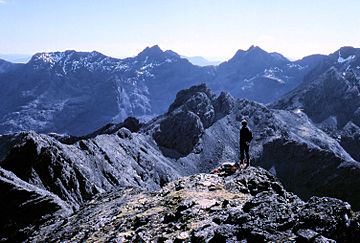
This book has been much discussed by experts. Some say his love poetry is timeless, while his political poems have not aged as well. But others disagree, saying his political poems are still relevant. One expert said that there has never been, and likely never will be, a series of love poems as influential in Gaelic literature.
Some critics tried to ignore the political side of MacLean's work. But others, like Seamus Heaney, saw Eimhir as a symbol. She represented the difficult choices between love and duty. Poet Iain Crichton Smith said the Spanish Civil War was not just a background to these poems, but a main character.
MacLean's work was new and important because it put Gaelic history next to major European events. He said his poetry "radiated from Skye and the West Highlands to the whole of Europe." By doing this, he showed the value of Gaelic tradition. He also showed that Gaels had the right to be equal in the wider world of culture.
In An Cuilthionn, the Cuillin mountains of Skye represent problems in European politics. The suffering of the Gaels during the Highland Clearances is compared to the suffering of people under fascist rule. MacLean often linked the unfairness of the Clearances to modern issues. He believed that the greed of the rich caused many tragedies.
This book made him known as "the major force in modern Gaelic poetry." One professor said, "After the publication of this book Gaelic poetry could never be the same again."
Becoming Widely Known
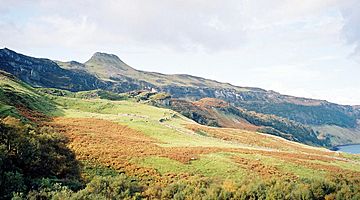
Even though his poetry greatly impacted the Gaelic world, it wasn't until the 1970s that English speakers could easily read MacLean's work. His book Dàin do Eimhir was not reprinted for a long time. So, it was hard for Gaelic speakers to get copies too.
In 1970, a magazine called Lines Review dedicated an issue to his work. Some of his poems also appeared in an anthology. This helped him become known to English speakers. Iain Crichton Smith published an English translation of Dàin do Eimhir in 1971.
MacLean was part of the Scottish group at the first Cambridge Poetry Festival in 1975. This helped build his reputation in England. In 1976, his poems were included in an important collection of modern Scottish Gaelic poems. He translated his own poems for this book.
In 1977, a book called Reothairt is Contraigh: Taghadh de Dhàin 1932–72 (Spring tide and Neap tide: Selected Poems 1932–72) was published. MacLean changed the order of his Dàin do Eimhir poems for this book. He also changed or removed some parts. For example, in the original An Cuilthionn, he had asked the Red Army to invade Scotland. This part was removed. MacLean said he would only publish parts of his old work that he found "tolerable." Most of the critics who praised him did not understand his poems in the original Gaelic.
In 1989, another collection, O Choille gu Bearradh / From Wood to Ridge: Collected Poems in Gaelic and English, brought him lasting fame. Later, full versions of his work with notes were published.
From the early 1970s, MacLean was invited to read his poetry around the world. He would first describe the images in a poem. Then, he would read it in Gaelic and again in English. He always said his English versions were not poems themselves. Even people who didn't speak Gaelic found his readings very moving. Seamus Heaney said MacLean's voice sounded both sad and joyful. These readings helped him become famous internationally. His poetry was also translated into German, and he read in Germany and Austria.
MacLean's most famous poem in the English-speaking world is Hallaig. It is about a village on Raasay that was emptied of its people. Raasay was cleared between 1852 and 1854. Most people were forced to leave. Many of MacLean's relatives were affected. Hallaig was one of the villages that lost its population.
He wrote the poem a century later, in 1954. It starts with the famous line, "Time, the deer, is in the wood of Hallaig." The poem imagines the village as it was before the Clearances. The people who died long ago are still walking through the trees. The poem also uses local names of people and places. These names have deeper meanings for those who know Raasay's oral traditions.
Unlike most of MacLean's poems, Hallaig does not directly mention politics or evictions. Because of this, it was seen as "safer" politically. Seamus Heaney translated and promoted it. Hallaig became very popular and came to represent Scottish Gaelic poetry to English speakers.
His Poetic Style
MacLean's poetry often used an older style of rhythm. This style was based on the lively patterns of spoken Gaelic stories and songs. It was different from the strict, unchanging rhythms of 19th-century written Gaelic poetry. He often mixed different rhythms and changed them within a poem. This created beautiful sounds that are hard to translate.
He used traditional Gaelic rhymes, both within lines and at the end of lines. These rhymes are common in old Gaelic songs. But some of his poems had less traditional rhyme schemes. He was flexible with his style, mixing old and new ways. This made his poetry unique in Gaelic literature. Over time, his poems became less strict with rhyme and rhythm.
MacLean's poems often used Gaelic themes. These included Scottish place names, trees, and symbols of the sea. Knowing these traditions helps people understand and enjoy his poetry even more. Another important symbol in his work is the face, which represents romantic love.
His poetry used a wide range of language. Some poems are easy to understand for Gaelic speakers. But others need more thought to figure out their meaning. MacLean rarely made up new words. However, he brought back many old or forgotten words. He often said he heard these old words in Presbyterian sermons. Experts say that MacLean's use of these old words changed Gaelic literature. It made the language feel new and modern.
In contrast, his English translations were very simple. They often lost the deeper meanings and sounds of the original Gaelic. This was because one English word had to stand for many meanings in Gaelic. MacLean always said his English versions were not poems themselves. Seamus Heaney called them "cribs" (like study guides).
Awards and Honours
In June 1987, MacLean became the first freeman of Skye and Lochalsh. He received seven honorary degrees from different universities. He was also the honorary head of the Gaelic Society of Inverness twice. In 1985, he became honorary president of the Saltire Society.
In 1989, he became a Fellow of the Royal Society of Literature. The next year, he was named the first University of Edinburgh Alumnus of the Year. He also received a Queen's Gold Medal for Poetry. His book O Choille gu Bearradh won the Scottish Book of the Year award in 1990. MacLean also won the McVitie's Prize for Scottish Writer of the Year.
He became a Fellow of the Educational Institute of Scotland in 1991. In 1992, he became a Fellow of the Royal Society of Edinburgh. He was also made an honorary fellow of the Royal Incorporation of Architects in Scotland and an honorary Royal Scottish Academician in 1996.
He was nominated for the Nobel Prize in Literature in 1992. Some people think he might have won if he had written in a more widely spoken language. MacLean is remembered with a stone in Makars' Court in Edinburgh. This stone was unveiled in 1998 by Iain Crichton Smith.
His Lasting Impact
Hugh MacDiarmid wrote to MacLean in 1977, saying that they were the best Scottish poets of the 20th century. MacDiarmid and MacLean influenced each other's work. Their many letters have been published. Douglas Young said that MacLean wrote "the best poetry written in our generation in the British Isles."
One expert called him a "masterful writer" who pushed Gaelic to its limits. He found it amazing that Gaelic, a language often ignored, could produce a writer like MacLean. He felt that MacLean needed Gaelic, and Gaelic needed MacLean. Iain Crichton Smith called Dàin do Eimhir "the greatest Gaelic book of this century." Another expert agreed.
Maoilios Caimbeul said MacLean was the best Scottish Gaelic poet of all time. Smith compared MacLean's love poetry to that of famous poets like Catullus and William Butler Yeats. Seamus Heaney said MacLean had "saved Gaelic poetry... for all time."
Some people felt it was a shame that in the 1980s, MacLean's work was seen as representing all Scottish Gaelic poetry. They argued that his poetry was "comparatively unGaelic" and harder for everyday Gaelic speakers to understand. However, others disagreed. They said his poetry was not elitist because it was "sincere" and spoke with "simple passionate intensity."
It was also difficult because traditional Gaelic poetry was often sung. Many fluent Gaelic speakers were not strong readers. To make MacLean's work more accessible, the Sorley MacLean Trust asked musicians to set some of his poems to music.
In the Gaelic-speaking world, MacLean's influence has been strong. Poet Aonghas MacNeacail started writing in English because he thought Gaelic literature was "dead." He said MacLean convinced him otherwise and inspired him to write in Gaelic. The Gaelic rock band Runrig even invited MacLean to read poetry on stage at one of their concerts.
However, MacLean had less impact on rural Gaelic communities. Some people preferred the work of local poets to MacLean's. Australian poet Les Murray said MacLean influenced his own work.
A film called Hallaig was made in 1984 by Timothy Neat. It included MacLean talking about what influenced his poetry. It also featured parts of his poems and Gaelic songs. The poem Hallaig is also part of an opera by Peter Maxwell Davies. MacLean's own reading of Hallaig was used in a music track by Martyn Bennett.
In 2000, a controversy happened. John MacLeod of MacLeod tried to sell the Cuillin mountain range on Skye. He wanted to use the money to fix Dunvegan Castle. His real estate company used parts of MacLean's poem An Cuilthionn to advertise the property. Many people felt this was wrong. The company apologized, and MacLean's wife accepted their apology.
See also
 In Spanish: Somhairle MacGill-Eain para niños
In Spanish: Somhairle MacGill-Eain para niños


